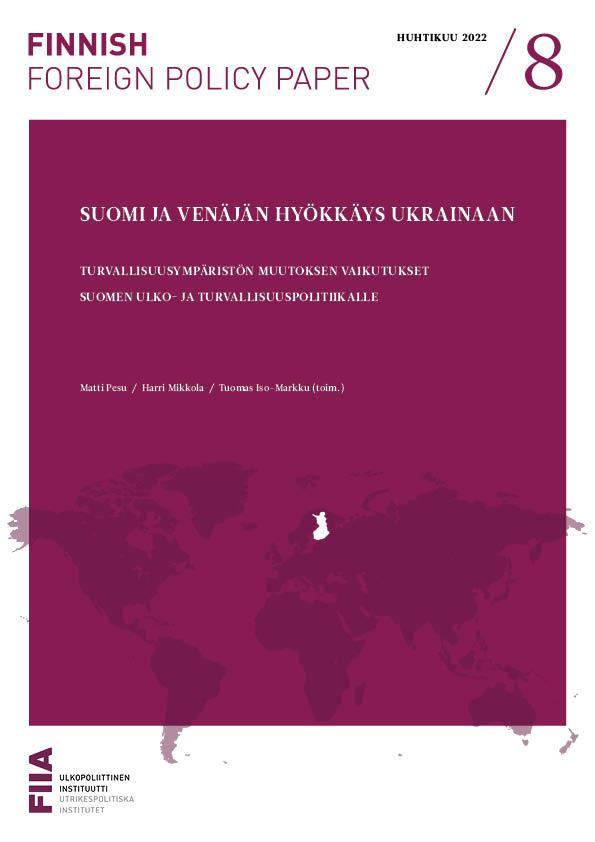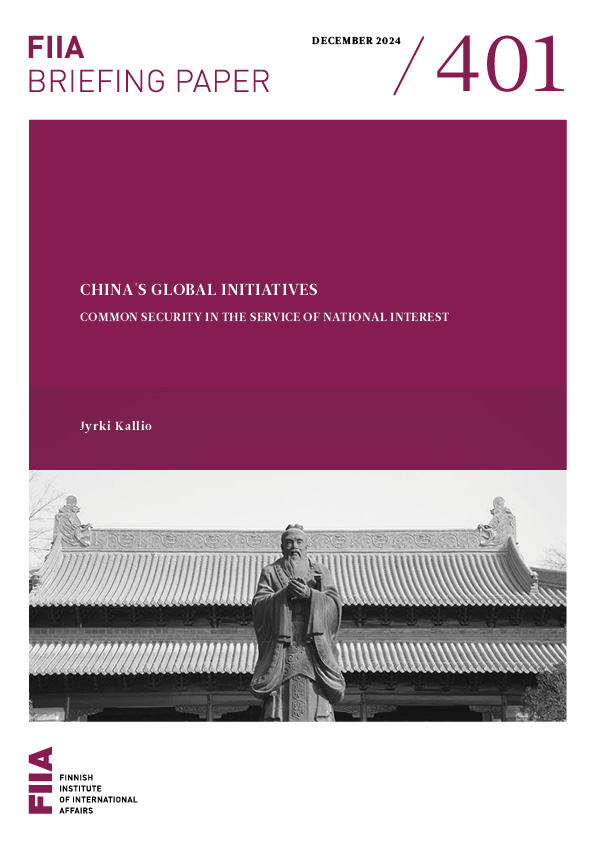At the NATO Madrid Summit in June 2022, Allies invited Finland and Sweden to join the NATO Alliance. In preparing for its membership, Finland will need to go through a reflection process on how it intends to contribute to NATO’s core tasks and make the most of its membership.
Finland should consider making substantial contributions to the deterrence and defence posture in the Baltic Sea region, including in the Baltic states, and elsewhere on the Eastern Flank. In parallel, Finland should also ensure it contributes to the Southern Flank.
Finland should aim to hit the ground running into the next cycle of the NATO Defence Planning Process (NDPP) and fulfil all relevant capability targets. Finland should also aim to “start strong to stay strong” on all existing NATO Pledges, notably those on defence investment, cyber-defence, and resilience.
It is typical for individual NATO Allies to seek a salient role when it comes to certain specific topics. For Finland, the Arctic (Northern Flank) and resilience seem most promising.
Introduction
On 18 May 2022, Finland and Sweden conveyed their intent to join the Alliance by submitting official letters of application to NATO. At the NATO Madrid Summit of 29–30 June 2022, Allied Heads of State and Government “decided to invite Finland and Sweden to become members of NATO, and agreed to sign the Accession Protocols”.[1] The inclusion of a promise to sign the Accession Protocols already at this stage indicates that the two nations benefit not only from full political support from all Allies,[2] but also that the process will likely be more rapid compared to recent enlargement rounds.[3]
The aim of this Briefing Paper is to provide reflections in support of Finland’s transition from an invitee to a member of the NATO Alliance. This transition implies a need for policy adaptation in the context of a deteriorated and evolving European and global security environment. Finland is not starting from scratch. As a long-standing and close partner of NATO, with substantial defence capabilities that possess an already high degree of interoperability with those of the Alliance, adaptation to NATO standards and to existing and foreseeable commitments is eminently feasible. Conversely, there is much work to do in a relatively short period. The underlying working assumption in this Briefing Paper is that Finland and Sweden will become members no later than the first half of 2023.
More fundamentally, being a NATO member will change Finland, perhaps more than some Finns expect. While the nation’s EU membership already transformed Finland to a considerable degree, joining the Atlantic Alliance implies a rethinking and a restructuring of the most sacred sovereign functions of the state. Every state has a unique lineage and history. For Finland, a hard-won independence and a distinguished record of fighting for survival against overwhelming odds have forged a uniquely resilient national spirit. Finland has come a long way from its relative isolation in the Cold War, thanks to its EU membership since 1995 and its close partnership with NATO. Finland also has close bilateral defence relationships with several existing NATO Allies, including the United States, the United Kingdom, and the Nordic Allies. Nonetheless, joining NATO is a deeper step into the realm of collective defence. What Finland once prepared for largely alone, it will soon prepare for in much closer concert with others. It is a shift from “one for one” to “one for all”, in reference to the informal motto of NATO’s sacred Article 5 commitment – “all for one and one for all”.
Defining a near-term agenda
NATO is a long-established international organization and has accepted other new members in recent years. Formal processes are akin to well-trained muscles and Finnish officials will find all the support they need as they prepare to join. Furthermore, as an invitee since 5 July 2022, Finland now has access to NATO meetings and documents. The goal in this Briefing Paper is therefore not to dwell on formal processes, but to set out thematic questions to help frame some key policy decisions which Finland will need to consider in the near term. Across all thematic questions, a general recommendation is that Finland, given its capabilities and resources, should aim to ‘start strong to stay strong’. On all relevant NATO commitments, pledges, and targets, Finland can and should aim to be a model Ally from the moment it enters the door.
The first question concerns the most pressing military issue, namely the Alliance’s deterrence and defence posture on its Eastern Flank, including in the Baltic Sea region, and Finland’s role and contribution towards that posture. The second question relates to Finland’s role in supporting the Alliance’s collective security needs on its Southern Flank.
The third question concerns Finland’s integration into NATO’s Defence Planning Process (NDPP). Ensuring the successful pursuit of all of its NDPP capability targets will require adequate defence budgeting, which is the fourth question.
Several core NATO activities are not addressed in this Briefing Paper, which aims to stay general and serve as an introduction. Areas of notable importance for future analyses include, in no particular order and among others: capability development, including the role of the Conference of National Armaments Directors (CNAD); NATO’s work on standardization; the NATO Science & Technology Organization; force readiness and military exercises in particular; cyber-defence; and work relating to emerging and disruptive technologies and innovation. In due course, Finnish officials will surely carry out a root-and-branch assessment of all relevant areas of work and take relevant decisions to ensure Finland is appropriately represented and involved in every area.
It is common for individual Allies to express a particular interest in certain areas of work and to play a greater leadership role in them. The fifth question, therefore, highlights two areas in which Finland may wish to propose to play a more salient role. The sixth and final question concerns how Finland’s broader foreign policy identity may evolve over time in light of its NATO membership. Summing up, our menu of questions is as follows:
1. Eastern Flank contributions
2. Southern Flank contributions
3. Defence planning and capability targets
4. Defence budgeting and budget planning
5. Topics of special interest to Finland
6. Finland’s future foreign policy identity
The sections that follow contain brief considerations of each of the six questions.
1. Eastern Flank contributions
Finland and Sweden are both Nordic nations and Baltic Sea nations. Their joining has far-reaching potential for a revised and stronger NATO deterrence and defence posture for the entire Nordic-Baltic region. One immediate effect of joining the Alliance will be a deepening of military ties with Estonia, Latvia, and Lithuania.
NATO’s existing ‘enhanced Forward Presence’ (eFP) was first established in 2017 with the creation of four multinational battalion-size battlegroups in Estonia, Latvia, Lithuania, and Poland. In February 2022, Allied force presence under the NATO flag was in a range of 1,000 to 1,700 troops in each nation.[4] The existence of the eFP does not preclude additional bilateral force presence. This has been particularly true for the additional bilateral US force presence in Poland, which was around 3,500 troops as of August 2020. In response to Russia’s war of aggression against Ukraine, NATO created four additional multinational battlegroups in Bulgaria, Hungary, Romania, and Slovakia,[5] and Allies also strengthened their force presence in the Baltic states and Poland, mainly through new bilateral contributions. As of June 2022, total Allied force presence was over 10,000 in Poland and over 2,000 in Estonia (see Figure 1).
As a result of these recent decisions, all of NATO’s Eastern Flank nations now host multinational NATO forces. Militarily speaking, Finland will be an Eastern Flank nation. The natural question is whether Finland should also host Allied forces on its territory. If so, one would need to consider the size and nature of the presence and which Allies would contribute. Conversely, as Allies contribute across the Eastern Flank, the related question is what forces Finland should deploy and where.

Figure 1. Allied force presence on NATO’s Eastern Flank as of June 2022
Source: NATO
In the air domain, Allies contribute to the NATO Air Policing mission in the Baltic states on a four-month rotational basis, with deployments to Šiauliai Air Base in Lithuania and Ämari Air Base in Estonia.[6] The question of how Finland and Sweden should contribute is already being posed. Indeed, the integration of the well-equipped air forces of both nations opens up possibilities for a broader re-think of air policing and air defence for the entire region. The maritime domain has received somewhat less public attention to date but should also be assessed. What future maritime force presence would Finland and its Allies like to see in the Baltic Sea? Would it warrant investments in new facilities? Finland may wish to have a clear view of the feasible range of contributions it would like to receive and to make in both the air and maritime domains in the region.
In the Madrid Summit Declaration, Allies committed to “deploy additional robust in-place combat-ready forces on [their] eastern flank, to be scaled up from the existing battlegroups to brigade-size units where and when required, underpinned by credible rapidly available reinforcements, prepositioned equipment, and enhanced command and control”. This strengthened forward presence offers an opportunity for Finland and Sweden to make contributions under the NATO flag, or bilaterally if they so choose.
A major overall development – for all strategic directions – is the creation of a new ‘NATO force model’ to replace the existing NATO Response Force. This would be based on three tiers.[7] Tier 1 forces would be deployable within 10 days, Tier 2 forces within 10 to 30 days, and Tier 3 forces within 30 to 180 days. There would be over 100,000 troops under Tier 1, around 200,000 under Tier 2, and at least 500,000 under Tier 3. As Finland and Sweden prepare to join, the question of how many troops and which formations each nation will contribute will be posed.
These four issues – boots on the ground in Eastern Flank nations, contributions to air policing in the Baltic Sea region, the maritime posture in the region, and the assignment of forces for the future NATO force model – are the most salient from both the military and political viewpoints. Alliance politics runs on voluntary commitments, with deployments of forces the strongest currency. Allies will naturally expect Finland and Sweden to be prepared to contribute, in a manner to be discussed based on relevant military advice.
2. Southern Flank contributions
The Southern strategic direction presents significant transnational threats and challenges, with impacts across the Alliance. For Mediterranean Allies, there is a need to feel assured that Allies from other regions are prepared to support them. Responding to such calls is good alliance politics.
The threat picture from the Southern direction is multifaceted and complex. One overall description is that these are “transnational threats such as terrorism, drug gangs, human traffickers and weapons smugglers [that] take advantage of ungoverned or loosely governed areas in the Middle East, North Africa and the Sahel to threaten peace inside NATO allies”. [8] Such security challenges can only partially be addressed with the military instrument of power. However, Allies and NATO have worked for many years with partner nations in those regions on defence reform, institution building, and capacity building. The aim is to facilitate long-term stability by supporting improved governance of national defence and security sectors and institutions. Working to enhance interoperability with partner nations also opens the door to partner participation in NATO-led operations and missions. These priorities also intersect with NATO’s work on countering terrorism,[9] which includes hands-on efforts in terms of threat awareness, capability development, operations, and training and education.
Finland should consider how it could contribute across this wide range of needs, following consultations with NATO staff and bilateral discussions with Mediterranean Allies.
3. Defence planning and capability targets
Once in NATO, Finland will participate in the NATO Defence Planning Process (NDPP). This will lead to capability targets which Finland will have to meet, while also pursuing EU goals such as the EU Capability Development Priorities. The NDPP runs according to a four-year cycle, with the overall political directives defined in a document called the Political Guidance. The last Political Guidance (PG) was in 2019, and the next PG will be defined in 2023. Following on the heels of the new Strategic Concept and the Madrid Summit, given the current security environment, the Level of Ambition that Allies choose will be high and transformative.[10]
It will be in the interests of both Finland and Sweden, already from this point on as invitees, to pay especially close attention to Defence Policy and Planning Committee meetings, notably those that pertain to preparing the new Political Guidance. This will help ensure the smooth integration of both nations into the NDPP.
4. Defence budgeting and budget planning
NATO’s Defence Investment Pledge of 2014 provides a clear commitment that will also apply to Finland – including the goals of spending at least 2% of GDP on defence every year, and of allocating at least 20% of that spending to major equipment and related R&D. The 2% goal is also highly important politically. It is the most common metric with which US audiences gauge the commitment of their European Allies.
These quantitative goals are correctly understood as floor values. With the Netherlands and Germany, among others, now credibly committed to moving towards 2%,[11] and with Poland moving towards 3%,[12] tolerance for Allies who remain under 2% is set to decrease. In the short term, Finland is in a good position given that its executed 2021 spending, budgeted 2022 spending, and planned 2023 spending are all above 2%. A possible best-practice idea would be for Finland to commit itself to maintaining defence spending above 2% for the foreseeable future, at a minimum through relevant white papers, and preferably also through a legal act. This would send a political signal both domestically and towards Allies that Finland clearly commits to long-term sustainment of defence investment levels that are consistent with NATO membership.
5. Topics of special interest to Finland
Individual Allies commonly identify a small number of areas of work in which they can make a distinct contribution, allowing them to both contribute more and to demonstrate leadership. Estonia, for example, is greatly respected in the field of cyber-defence. An individual Ally may, for example, be the host nation for a NATO facility, or for a NATO Centre of Excellence. Other possibilities include being the lead nation or framework nation for a given activity. Providing seconded officials (Voluntary National Contributions, VNCs) to NATO bodies is also an effective way of contributing to a particular area of work. Two topics are proposed for further consideration, namely Arctic security, referred to below as the Northern Flank, and resilience.
Northern Flank contributions
Finland will also be a Northern Flank nation. Its NATO membership will provide the Alliance with an enhanced capability to defend its Northern Flank. Today, five Arctic states are members of NATO and the Alliance’s collective defence also applies in the Arctic. However, the Arctic also plays a pivotal role in Russia’s great-power ambitions. Its nuclear-armed submarines operating under the Arctic Ocean ice cap provide Russia with a second-strike capability in the event of a nuclear war. Secondly, the Arctic Ocean provides Russia with its only uncontested access to the Atlantic Ocean.
In the event of a major military conflict between Russia and NATO, the sea lines of communication in the North Atlantic would play an essential role for the reinforcement of forces from North America to Europe. In this scenario, Russia may seek to disrupt these lines of communication to delay or prevent NATO reinforcements. Russian sub-surface operations in the North Atlantic could also pose a risk to NATO’s strategic deterrence forces, as well as to critical data cables connecting Europe and North America. However, to be able to operate in the North Atlantic, Russian vessels and submarines would need to enter the North Atlantic from the Arctic through the Greenland-Iceland-United Kingdom Gap (GIUK Gap). It is of great importance for NATO to be able to project force in this region, including through adequate maritime awareness and anti-submarine warfare capabilities. Finland’s NATO membership will provide the Alliance with an enhanced ability to pursue these objectives.
Resilience
In 2016, NATO members agreed resilience guidelines and pledged to achieve Baseline Requirements for National Resilience. They further agreed a Strengthened Resilience Commitment in 2021. There are seven baseline requirements against which Allies measure their level of preparedness, which reflect the core functions of continuity of government, essential services to the population, and civil support to the military. In the Madrid Summit Declaration, Allies declared that NATO work on resilience would be enhanced “including through nationally-developed goals and implementation plans”. As an Enhanced Opportunities Partner, Finland has already conducted crisis preparedness cooperation inside NATO structures and has actively participated in NATO meetings on resilience, ensuring a good degree of familiarity with pre-existing NATO work in this area.
Finland could make a distinctive contribution to the Alliance in the field of resilience. It has a strong track record in civil preparedness planning as part of its comprehensive security model, including a high level of competence in matters of security of supply, owing to the nation’s geographic isolation from mainland Europe. Finnish expertise and best practices could benefit other Allies, and therefore Finland may wish to study options for concrete proposals that it could make through appropriate channels.
6. Finland’s future foreign policy identity
There are arguably two ways of looking at Finland’s integration into NATO – an evolutionary view that stresses continuity and a revolutionary view that stresses change.
The evolutionary view emphasizes Finland’s existing EU membership, experience as a NATO partner, and existing defence relations with, among others, the United States, the United Kingdom, and Nordic Allies. This view explains why Finland can join so quickly and easily: it is already largely interoperable and promises to be a fast learner for everything else – indeed a net contributor in certain areas. That view implicitly stresses Finland’s identity as a Nordic nation, looking up to Sweden as the natural tandem partner to coordinate with while going in, and to Norway as a model NATO member to learn from. That view also implies seeing Germany in a pivotal role, as is the case in the EU.
The revolutionary view stresses both the origin and the destination of the journey. Finland is joining in reaction to Russia’s war of aggression and in order to benefit from a mutual defence clause with the United States. This view implies seeing the United States in the pivotal role and secondarily the United Kingdom as an important Ally to work with. This view also implicitly emphasizes another dimension of Finland’s geography, namely its Baltic aspect, on the Baltic Sea and bordering Russia, like the Baltic states. Ultimately, the revolutionary view is about Finland turning its back on Russia and breaking the last vestiges of any hold Moscow still has on Helsinki through implicit threats of coercion. And should there ever be a next time, Finland will not be fighting alone, and that is the point. In that sense, Finland has more in common with Eastern Flank Allies than with Nordic Allies.
Both views are correct. The evolutionary view explains why Finland’s integration into NATO will be rapid, successful, and smooth. It is also consistent with the specific expertise Finland may wish to propose relating to the Arctic and to resilience. The revolutionary view has more to say about Finland’s sense of itself and likely changes to its foreign policy identity.
The revolutionary view is also strengthened by the fact that the Alliance that Finland is about to join is not the Alliance that existed on 23 February 2022, let alone the one that existed in January 2014. Russia’s war of aggression against Ukraine pushes NATO, for the second time since the end of the Cold War, further and more decisively towards a core focus on deterrence and defence against Russia, including through a substantial expansion of high-readiness forces and of the Alliance’s posture on the Eastern Flank. This is where Finland’s contributions will matter most and be most expected, and this is why a further rapprochement between Finland and the Baltic states, and firstly with Estonia, will naturally occur and should be pursued proactively.
Key takeaways
As Finland prepares to join NATO, the most immediate need is to study what contributions should be made to strengthen NATO’s deterrence and defence posture on the Eastern Flank and in the Baltic Sea region. In parallel, good alliance politics dictates that Finland should aim to contribute on the Southern Flank as well. Finland should aim for a seamless integration into the next cycle of the NATO Defence Planning Process (NDPP) and aim to ‘start strong to stay strong’ on NDPP capability targets, as well as on all other NATO commitments and pledges.
Individual NATO Allies typically aim to be more salient than others in a small number of areas. The Arctic (Northern Flank) and Resilience are two possible areas that Finland could consider.
Finland is both a Nordic and Northern Flank nation, with much in common with Sweden and Norway, and a Baltic and Eastern Flank nation, with much in common with Estonia. Entering NATO will be both a natural evolution and a deeper revolution in Finland’s security and defence policies. The integration of these contrasting perspectives will shape Finland’s future foreign policy identity.
Endnotes
[1] NATO (2022). “Madrid Summit Declaration”. Press Release (2022) 095. 29 June.
[2] This was also clarified by Turkey the day before the Summit through a trilateral memorandum with Finland and Sweden which addresses specific Turkish security concerns.
[3] By way of illustration, the 2002 Summit Declaration wording for Bulgaria, Estonia, Latvia, Lithuania, Romania, Slovakia, and Slovenia was merely to “begin accession talks to join our Alliance”. Sixteen months elapsed between that declaration on 21 November 2002 and their accession on 29 March 2004.
[4] NATO (2022). NATO’s Enhanced Forward Presence. Online Factsheet, February. Available at: https://www.nato.int/nato_static_fl2014/assets/pdf/2022/2/pdf/2202-factsheet_efp_en.pdf.
[5] NATO (2022). Statement by NATO Heads of State and Government. 24 March. Available at: https://www.nato.int/cps/en/natohq/official_texts_193719.htm.
[6] See https://www.nato.int/cps/en/natohq/topics_132685.htm.
[7] NATO (2022). “New NATO Force Model”. Online Infographic.
[8] Jim Garamone (2019). “NATO Using New Mission Set to Address Southern Flank”. DOD News. US Department of Defense.
[9] See https://www.nato.int/cps/en/natohq/topics_77646.htm.
[10] The Level of Ambition is the definition of the number, scale and nature of the operations the Alliance should be able to conduct in the future.
[11] Jim Garamone (2022). “Biden Says NATO Meets Challenges of Today, Prepares to Counter Threats of Tomorrow”. DOD News, 30 June.
[12] TVP World (2022). “President signs Homeland Defence act”, 12 March.








